Experimental Study on the Shear-Flow Coupled Behavior of Tension Fractures Under Constant Normal Stiffness Boundary Conditions
Abstract
1. Introduction
2. Experiment
2.1. Specimen Preparation
2.2. Test Equipment and Procedures
3. Experimental Results
3.1. Effect of the Normal Stiffness on the Shear Characteristics
3.2. Effect of the Initial Normal Stress on the Shear Characteristics
3.3. Evolution of Transmissivity during the Shear-Flow Tests
3.4. Evolutions of the Mechanical Aperture and the Hydraulic Aperture
4. Conclusions
Author Contributions
Funding
Conflicts of Interest
References
- Jiang, Y.J.; Tanabashi, Y.; Xiao, J.; Nagaie. An improved shear-flow test apparatus and its application to deep underground construction. Int. J. Rock Mech. Min. Sci. 2004, 41, 170–175. [Google Scholar] [CrossRef]
- Wu, X.Z.; Jiang, Y.J.; Guan, Z.C.; Wang, G. Estimating the support effect of energy-absorbing rock bolts based on the mechanical work transfer ability. Int. J. Rock Mech. Min. Sci. 2018, 103, 168–178. [Google Scholar] [CrossRef]
- Barton, N.; Bandis, S.; Bakhtar, K. Strength, deformation and conductivity coupling of rock joints. Int. J. Rock Mech. Min. Sci. 1985, 22, 121–140. [Google Scholar] [CrossRef]
- Makurat, A. The effect of shear displacement on the permeability of natural rough joints. Hydrogeology of rocks of low permeability. In Proceedings of the 17th International Congress on Hydrogeology, Tucson, AZ, USA, 7–12 January 1985; pp. 99–106. [Google Scholar]
- Makurat, A.; Barton, N.; Rad, N.S.; Bandis, S. Joint conductivity variation due to normal and shear deformation. In Proceedings of the International Symposium on Rock Joints, Balkema, Loen, Norway, 4–6 June 1990; pp. 535–540. [Google Scholar]
- Yang, S.Q.; Liu, X.R.; Jing, H.W. Experimental investigation on fracture coalescence behavior of red sandstone containing two unparallel fissures under uniaxial compression. Int. J. Rock Mech. Min. Sci. 2013, 63, 82–92. [Google Scholar] [CrossRef]
- Yang, S.Q.; Yang, D.S.; Jing, H.W.; Li, Y.H.; Wang, S.Y. An experimental study of the fracture coalescence behaviour of brittle sandstone specimens containing three fissures. Rock Mech. Rock Eng. 2012, 45, 563–582. [Google Scholar] [CrossRef]
- Mazumber, K.; Karnik, A.A.; Wolf, K.H.A.A. Swelling of coal in response to CO2 sequestration for ECBM and its effect on fracture permeability. SPE J. 2006, 11, 390–398. [Google Scholar] [CrossRef]
- Schmittbuhl, J.; Steyer, A.; Jouniaux, L.; Toussaint, R. Fracture morphology and viscous transport. Int. J. Rock Mech. Min. Sci. 2008, 45, 422–430. [Google Scholar] [CrossRef]
- Leung, C.T.O.; Zimmerman, R.W. Estimating the hydraulic conductivity of two-dimensional fracture networks using network geometric properties. Transp. Porous Media 2012, 93, 777–797. [Google Scholar] [CrossRef]
- Wang, C.G.; Zhai, P.C.; Chen, Z.W.; Liu, J.S.; Wang, L.S.; Xie, J. Experimental study of coal matrix-cleat interaction under constant volume boundary condition. Int. J. Coal Geol. 2017, 181, 124–132. [Google Scholar] [CrossRef]
- Liu, R.; Li, B.; Jing, H.; Wei, W. Analytical solutions for water-gas flow through 3D rock fracture networks subjected to triaxial stresses. Fractals 2018, 26, 1850053. [Google Scholar] [CrossRef]
- Yeo, I.W.; Freitas, M.H.D.; Zimmerman, R.W. Effect of shear displacement on the aperture and permeability of a rock fracture. Int. J. Rock Mech. Min. Sci. 1998, 35, 1051–1070. [Google Scholar] [CrossRef]
- Esaki, T.; Du, S.; Mitani, Y.; Jing, L. Development of a shear-flow test apparatus and determination of coupled properties for a single rock joint. Int. J. Rock Mech. Min. Sci. 1999, 36, 641–650. [Google Scholar] [CrossRef]
- Li, B.; Jiang, Y.J.; Koyama, T.; Jing, L.R. Experimental study of the hydro-mechanical behavior of rock joints using a parallel-plate model containing contact areas and artificial fractures. Int. J. Rock Mech. Min. Sci. 2008, 45, 362–375. [Google Scholar] [CrossRef]
- Javadi, M.; Sharifzadeh, M.; Shahriar, K.; Mitani, Y. Critical Reynolds number for nonlinear flow through rough-walled fractures: The role of shear processes. Water Resour. Res. 2010, 389, 18–30. [Google Scholar] [CrossRef]
- Frash, L.P.; Carey, J.W.; Lei, Z.; Rougier, E.; Ickes, T.; Viswanathan, H.S. High-stress triaxial direct-shear fracturing of Utica shale and in situ X-ray microtomography with permeability measurement. J. Geophys. Res. Solid Earth 2016, 121, 5493–5508. [Google Scholar] [CrossRef]
- Frash, L.P.; Carey, J.W.; Ickes, T.; Porter, M.L.; Viswanathan, H.S. Permeability of fractures created by triaxial direct shear and simultaneous X-ray imaging. In Proceedings of the 51st U.S. Rock Mechanics/Geomechanics Symposium, San Francisco, CA, USA, 25–28 June 2017. [Google Scholar]
- Rong, G.; Yang, J.; Cheng, L.; Zhou, C.B. Laboratory investigation of nonlinear flow characteristics in rough fractures during shear process. J. Hydrol. 2016, 541, 1385–1394. [Google Scholar] [CrossRef]
- Jiang, Y.J.; Xiao, J.; Tanabashi, Y.; Mizokami, T. Development of an automated servo-controlled direct shear apparatus applying a constant normal stiffness condition. Int. J. Rock Mech. Min. Sci. 2004, 41, 275–286. [Google Scholar] [CrossRef]
- Jiang, Y.J.; Li, B.; Tanabashi, Y. Estimating the relation between surface roughness and mechanical properties of rock joints. Int. J. Rock Mech. Min. Sci. 2006, 43, 837–846. [Google Scholar] [CrossRef]
- Lee, Y.K.; Park, J.W.; Song, J.J. Model for the shear behavior of rock joints under CNL and CNS conditions. Int. J. Rock Mech. Min. Sci. 2014, 70, 252–263. [Google Scholar] [CrossRef]
- Shrivastava, A.K.; Rao, K.S. Physical modeling of shear behavior of infilled rock joints under CNL and CNS boundary conditions. Rock Mech. Rock Eng. 2017, 51, 101–118. [Google Scholar] [CrossRef]
- Li, Y.C.; Wu, W.; Li, B. An analytical model for two-order asperity degradation of rock joints under constant normal stiffness conditions. Rock Mech. Rock Eng. 2018, 51, 1431–1445. [Google Scholar] [CrossRef]
- Indraratna, B.; Haque, A. Experimental study of shear behavior of rock joints under constant normal stiffness conditions. Int. J. Rock Mech. Min. Sci. 1997, 34, 3–4. [Google Scholar] [CrossRef]
- Shrivastava, A.K.; Rao, K.S. Shear behaviour of rock joints under CNL and CNS Boundary Conditions. Geotech. Geol. Eng. 2015, 33, 1205–1220. [Google Scholar] [CrossRef]
- Mirzaghorbanali, A.; Nemcik, J.; Aziz, N. Effects of cyclic loading on the shear behaviour of infilled rock joints under constant normal stiffness conditions. Rock Mech. Rock Eng. 2014, 47, 1373–1391. [Google Scholar] [CrossRef]
- Li, B.; Jiang, Y.J.; Saho, R.; Tasaku, Y.; Tanabashi, Y. An investigation of hydromechanical behaviour and transportability of rock joints. Asian Joint Symp. Geotech. Geo-Environ. Eng. 2006, 321–325. [Google Scholar]
- Koyama, T.; Li, B.; Jiang, Y.J.; Jing, L.R. Numerical modelling of fluid flow tests in a rock fracture with a special algorithm for contact areas. Comput. Geotech. 2009, 36, 291–303. [Google Scholar] [CrossRef]
- Olsson, R.; Lindblom, U. Direct Shear Tests Under Constant Normal Stiffness and Fluid Flow. In Proceedings of the 9th ISRM Congress, Paris, France, 25–28 August 1999. [Google Scholar]
- Olsson, R.; Barton, N. An improved model for hydromechanical coupling during shearing of rock joints. Int. J. Rock Mech. Min. Sci. 2001, 38, 317–329. [Google Scholar] [CrossRef]
- Saito, R.; Ohnishi, Y.; Nishiyama, S.; Yano, T.; Uehara, S. Hydraulic characteristics of single rough fracture under shear deformation. In Proceedings of the ISRM International Symposium (EUROCK), Brno, Czech Republic, 18–20 May 2005; pp. 503–509. [Google Scholar]
- Tse, R.; Cruden, D.M. Estimating joint roughness coefficients. Int. J. Rock Mech. Min. Sci. Geomech. Abstr. 1979, 16, 303–307. [Google Scholar] [CrossRef]
- Xiong, X.B.; Li, B.; Jiang, Y.J.; Koyama, T.; Zhang, C.H. Experimental and numerical study of the geometrical and hydraulic characteristics of a single rock fracture during shear. Int. J. Rock Mech. Min. Sci. 2011, 48, 1292–1302. [Google Scholar] [CrossRef]
- Koyama, T.; Li, B.; Jiang, Y.J.; Jing, L.R. Coupled shear-flow tests for rock fractures with visualization of the fluid flow and their numerical simulations. Int. J. Geotech. Eng. 2012, 2, 215–227. [Google Scholar] [CrossRef]
- Yin, Q.; Jing, H.W.; Ma, G.W.; Su, H.; Liu, R.C. Investigating the roles of included angle and loading condition on the critical hydraulic gradient of real rock fracture networks. Rock Mech. Rock Eng. 2018, 51, 3167–3177. [Google Scholar] [CrossRef]
- Yin, Q.; Ma, G.W.; Jing, H.W.; Su, H.; Wang, Y.; Liu, R.C. Hydraulic properties of 3D rough-walled fractures during shearing: An experimental study. J. Hydrol. 2017, 555, 169–184. [Google Scholar] [CrossRef]
- Liu, R.C.; Jing, H.W.; He, L.; Zhu, T.; Yu, L. An experimental study of the effect of fillings on hydraulic properties of single fractures. Environ. Earth Sci. 2017, 76, 684. [Google Scholar] [CrossRef]

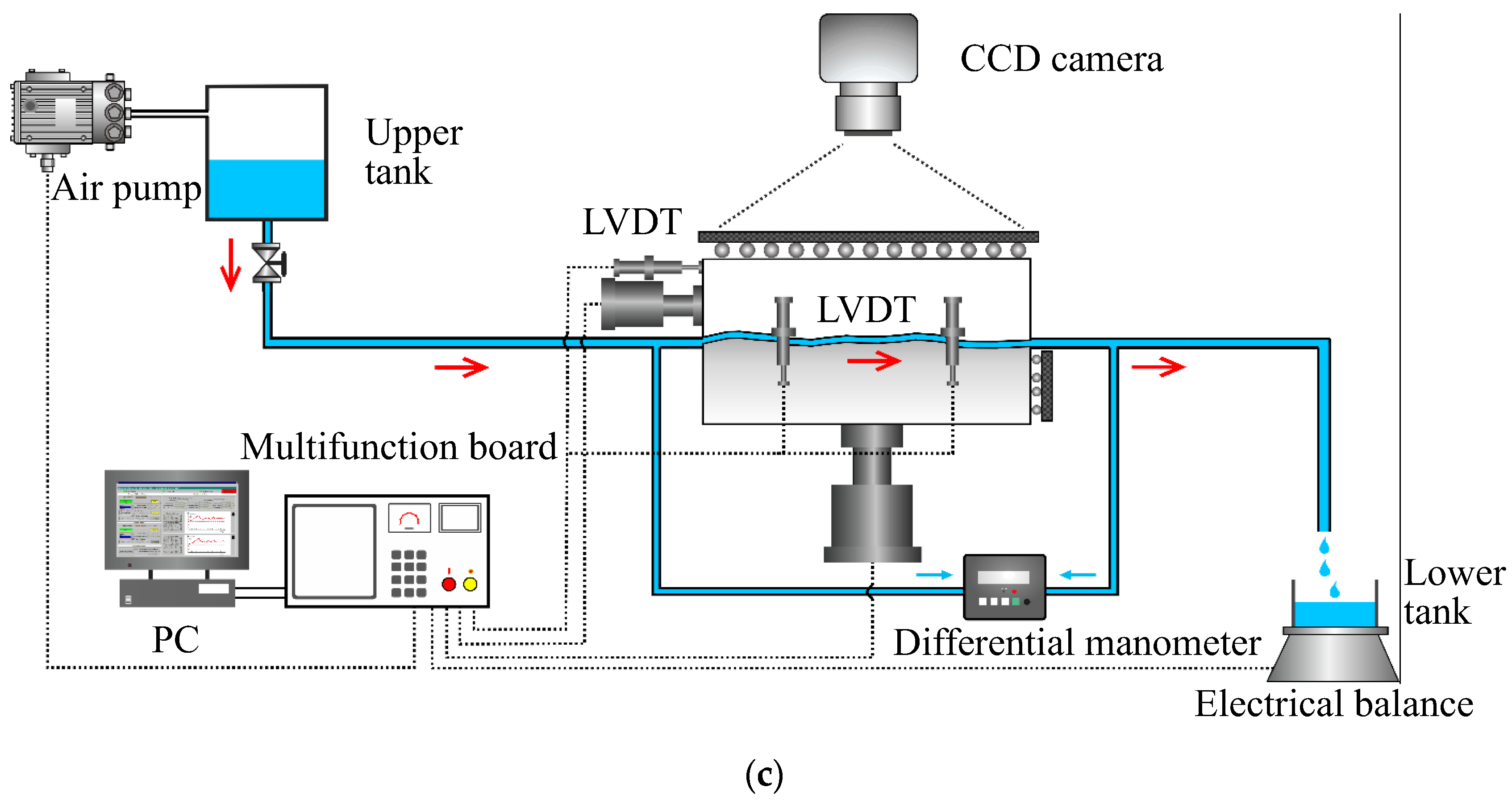
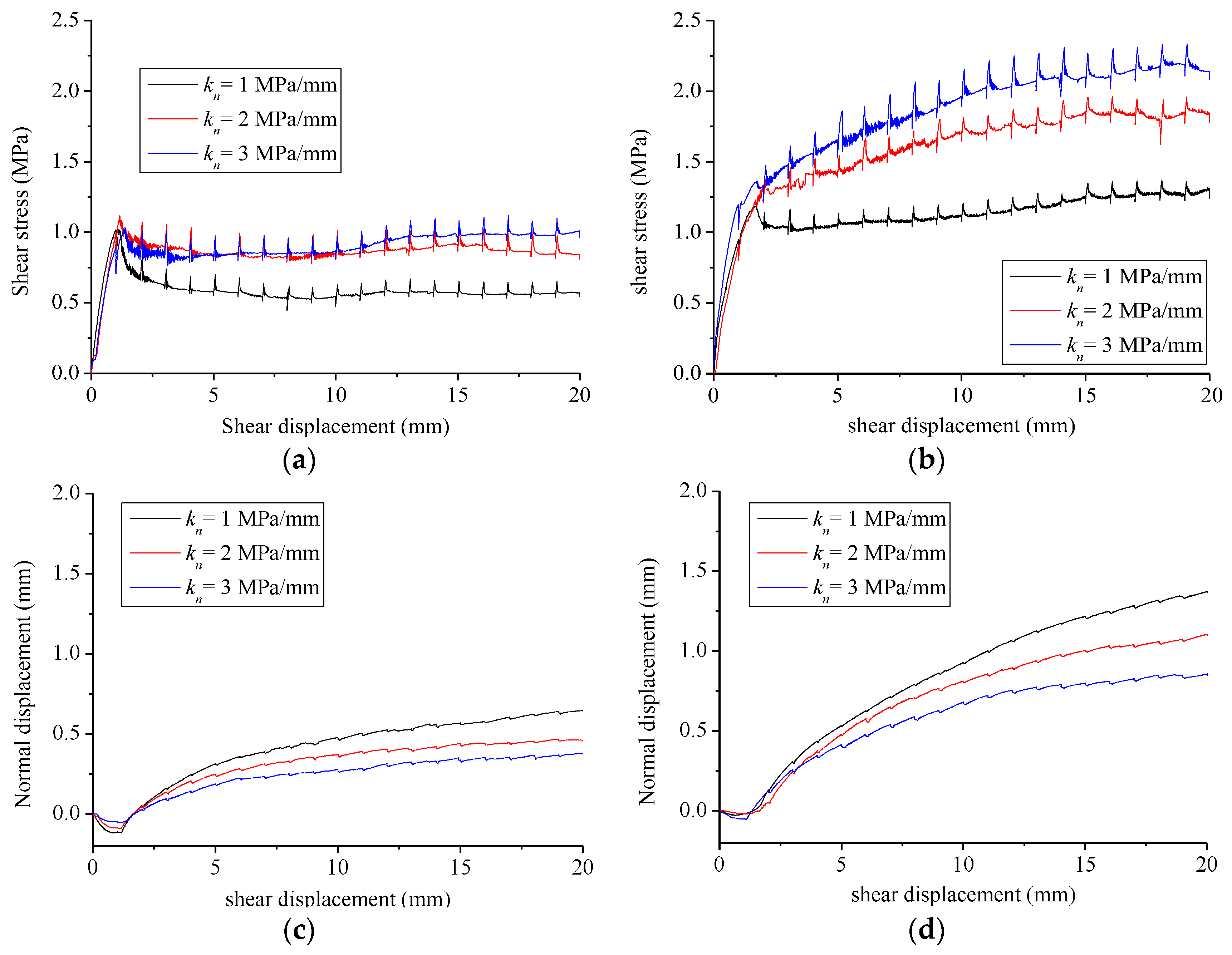

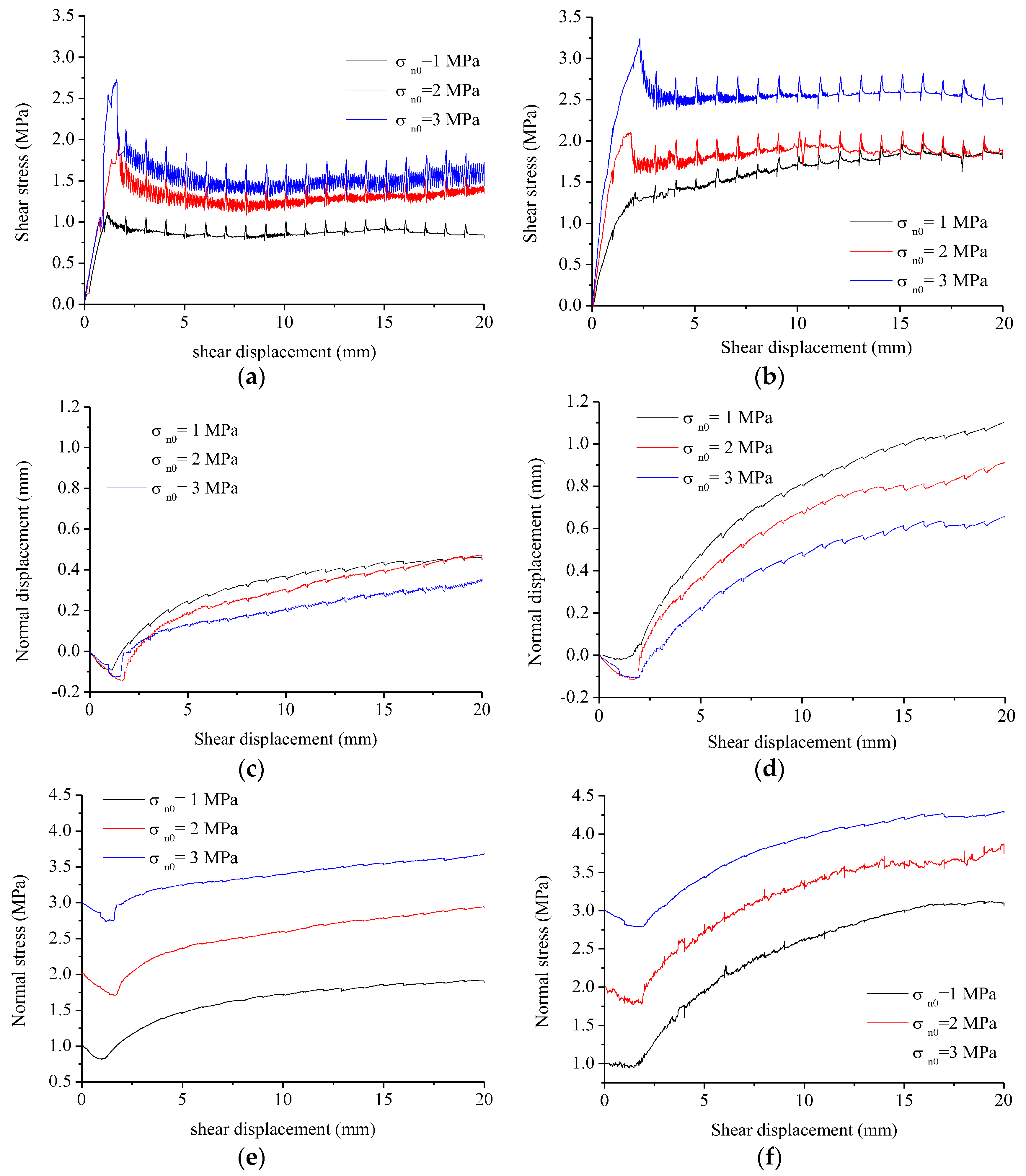
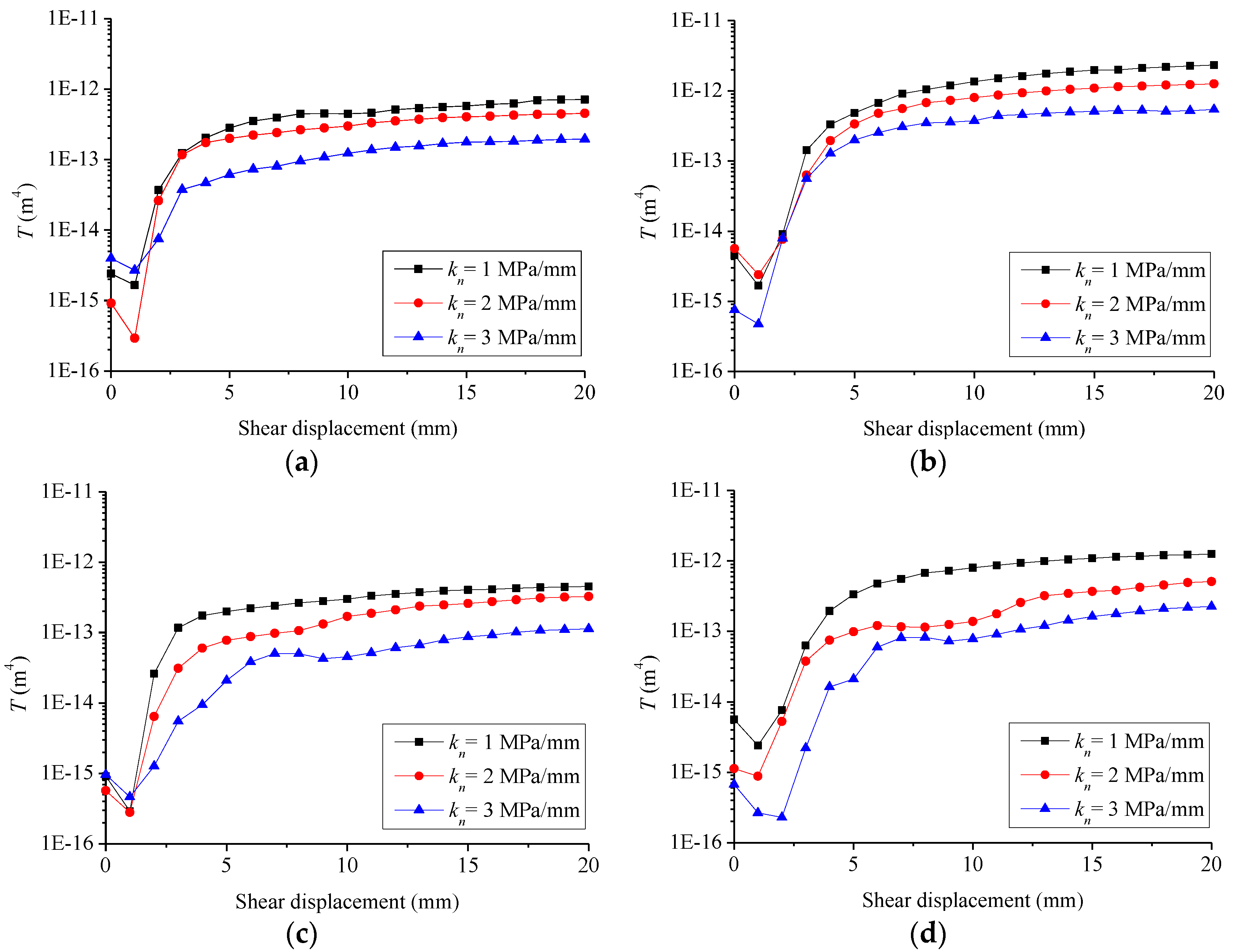
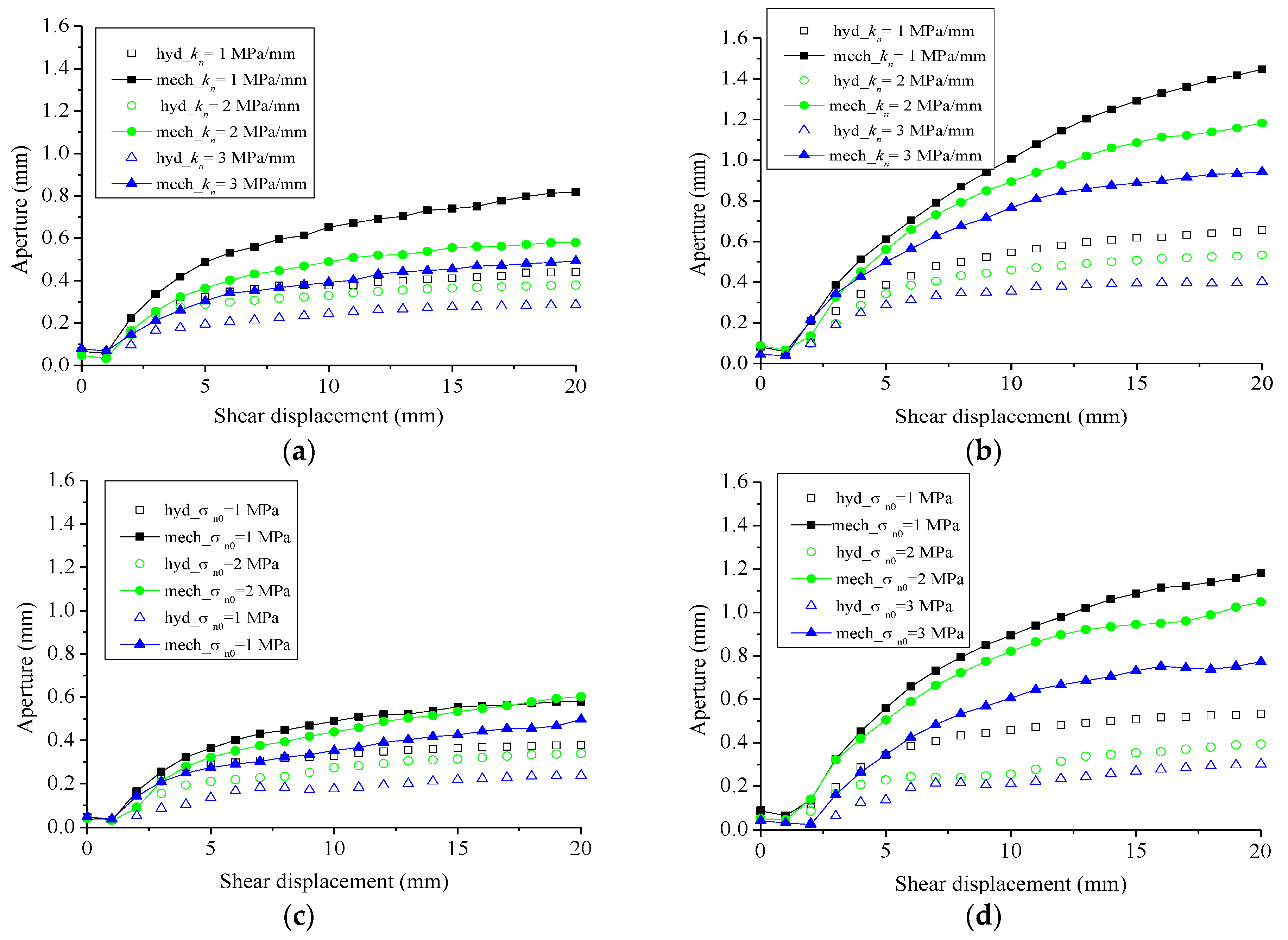
| Physico-Mechanical Properties | Index | Unit | Value |
|---|---|---|---|
| Density | ρ | g/cm3 | 2.066 |
| Compressive strength | σc | MPa | 38.5 |
| Modulus of elasticity | Es | GPa | 28.7 |
| Poisson’s ratio | v | – | 0.23 |
| Tensile strength | σt | σt | 2.5 |
| Cohesion | c | MPa | 5.3 |
| Internal friction angle | φ | ° | 60 |
| Joint Specimens | Loading Cases | Roughness (JRC) | Normal Loading Conditions | |
|---|---|---|---|---|
| Initial Normal Stress, (MPa) | Normal Stiffness, kn (MPa/mm) | |||
| G1 | G1—1 | 3.21 | 1 | 1 |
| G1—2 | 1 | 2 | ||
| G1—3 | 1 | 3 | ||
| G1—4 | 2 | 2 | ||
| G1—5 | 3 | 2 | ||
| G3 | G3—1 | 7.36 | 1 | 1 |
| G3—2 | 1 | 2 | ||
| G3—3 | 1 | 3 | ||
| G3—4 | 2 | 2 | ||
| G3—5 | 3 | 2 | ||
© 2019 by the authors. Licensee MDPI, Basel, Switzerland. This article is an open access article distributed under the terms and conditions of the Creative Commons Attribution (CC BY) license (http://creativecommons.org/licenses/by/4.0/).
Share and Cite
Wang, C.; Jiang, Y.; Luan, H.; Liu, J.; Sugimoto, S. Experimental Study on the Shear-Flow Coupled Behavior of Tension Fractures Under Constant Normal Stiffness Boundary Conditions. Processes 2019, 7, 57. https://doi.org/10.3390/pr7020057
Wang C, Jiang Y, Luan H, Liu J, Sugimoto S. Experimental Study on the Shear-Flow Coupled Behavior of Tension Fractures Under Constant Normal Stiffness Boundary Conditions. Processes. 2019; 7(2):57. https://doi.org/10.3390/pr7020057
Chicago/Turabian StyleWang, Changsheng, Yujing Jiang, Hengjie Luan, Jiankang Liu, and Satoshi Sugimoto. 2019. "Experimental Study on the Shear-Flow Coupled Behavior of Tension Fractures Under Constant Normal Stiffness Boundary Conditions" Processes 7, no. 2: 57. https://doi.org/10.3390/pr7020057
APA StyleWang, C., Jiang, Y., Luan, H., Liu, J., & Sugimoto, S. (2019). Experimental Study on the Shear-Flow Coupled Behavior of Tension Fractures Under Constant Normal Stiffness Boundary Conditions. Processes, 7(2), 57. https://doi.org/10.3390/pr7020057








